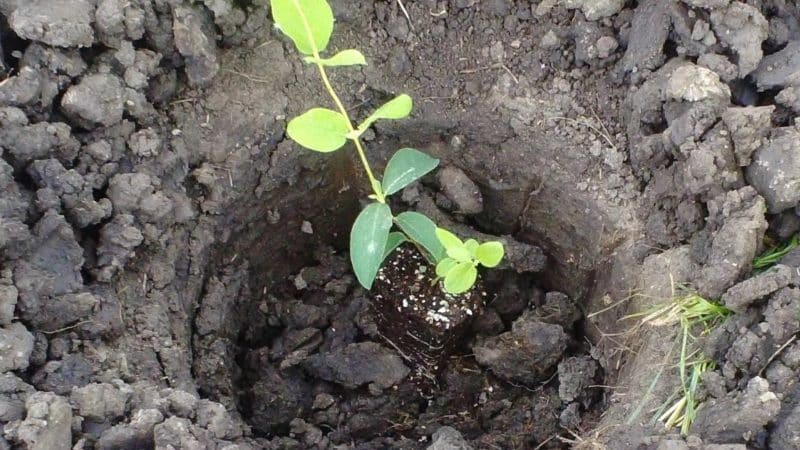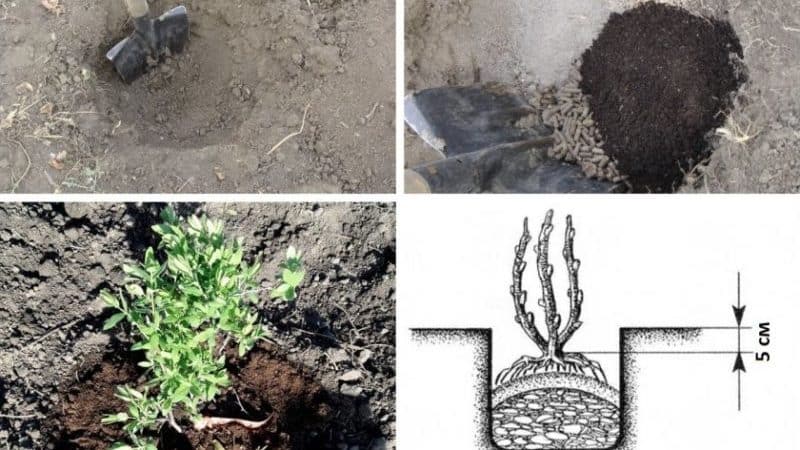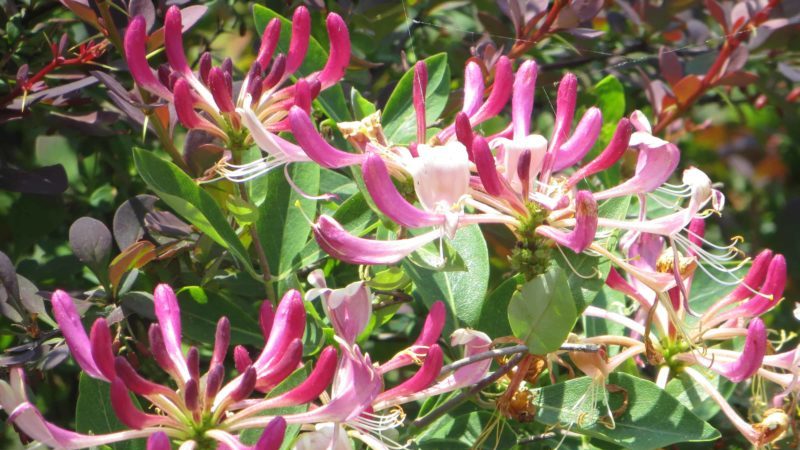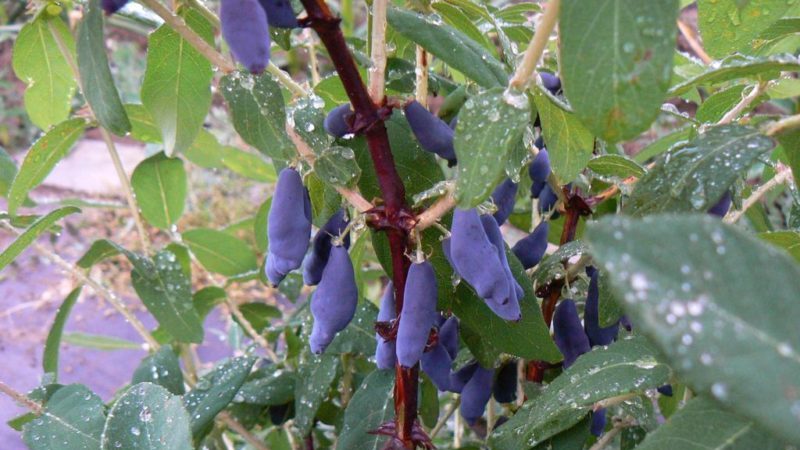Growing honeysuckle honeysuckle: planting, care, propagation
Honeysuckle honeysuckle is a climbing ornamental plant that is used in landscape design as a garden decoration or the main element of living gazebos, hedges and partitions for zoning an area.
Decorative honeysuckle attracts gardeners not only with its fragrant flowers, but also with its bright fruits and unusual leaves. It remains beautiful from early spring to late autumn. Knowing the basic rules of planting and care, honeysuckle honeysuckle can be grown even by an inexperienced gardener.
Planting honeysuckle honeysuckle in open ground
Honeysuckle honeysuckle is a vine with abundant flowering, during which a pleasant rich aroma emanates from the thickets. Even when the plant is not blooming, it remains attractive thanks to its unusual bluish and green leaves and colorful, although inedible, berries.
The result of growing honeysuckle largely depends on how correctly the planting was done. It is very important to go through the main stages.

Deadlines
Honeysuckle seedlings are planted in open ground in late autumn or early spring.
When planting in the fall, choose the leaf fall period - the second half of October or November. The soil at this time has not yet had time to freeze, there are no sub-zero temperatures. The plant has enough time to take root before frost.
In the second case, they are planted in early spring. By this time, the soil has thawed and the threat of return frosts has passed.
Selection of seedlings

Honeysuckle seedlings are sold in markets and specialized stores. In both cases, it is important to choose high-quality planting material.
Pay attention to the following parameters:
- Presence of kidneys. This increases the likelihood that the seedlings will take root on the site.
- Appearance. The branches must be elastic, not dry, without cracks or other damage.
- Root system. Buy seedlings with a closed root system, which ensures better survival on the site, or with a well-developed open root system without damage.
Before planting, the seedling is soaked for 2 hours in a growth stimulator, for example, in “Solution”.
Selecting a location
The chosen location determines how quickly the vine will grow and how abundant its flowering will be.
Honeysuckle grows in sunny and semi-shaded areas. In the first case, flowering will be more abundant.
The liana is moisture-loving and is not afraid of close proximity to groundwater. Loose, nutritious soils are suitable for it. It is desirable that the soil is slightly acidic, but the plant can grow in alkaline and acidic soil.
It is not recommended to replant honeysuckle. A permanent place is immediately chosen for it near the grid, the facade of a building or other support. The plant will even trail along a tree trunk.
Advice. Behind the climbing honeysuckle you can hide the unattractive facade of the building.
Soil preparation
The landing site is prepared in advance:
- Dig holes 50 cm deep and 50 cm in diameter. Keep a distance of at least 1.5 m between holes.
- Drainage is poured into the bottom of the hole to prevent liquid stagnation: shell rock, sawdust, crushed expanded clay, broken ceramic ware or brick.
- The soil that was removed from the hole is mixed with peat, manure or humus, and a baking powder - sand - is added. For 3 parts of garden soil, take 1 part nutrient substrate and 1 part baking powder.
- A dark pink solution of potassium permanganate or a solution of copper sulfate is poured into the hole.
The soil is prepared 2 days before planting.
Planting process

Instructions for planting honeysuckle:
- At the bottom of the hole, a mound of soil mixture is formed.
- The roots of the seedling are cut by 1/3. The plant is placed in the center of the hole. The roots are carefully distributed around the mound.
- The hole is covered with earth and watered with settled water at room temperature. Use up to a bucket of water per plant.
- When the water is absorbed, the soil around the seedling is compacted. The seedling is watered again.
- The soil around the honeysuckle is mulched with humus or peat.
Honeysuckle care
We will tell you the basic rules for caring for honeysuckle.
Watering
The first time honeysuckle is watered with warm, settled water 2 weeks after planting. Use 1-2 buckets of water per plant. Honeysuckle is watered once a week. In hot, dry weather, the amount of watering is increased to 2 times every 7 days.
Loosening
The soil is loosened after each watering and precipitation to destroy the earth crust and normalize root air exchange. During the loosening process, weeds are removed.
Fertilizing
The first fertilizing is applied 3 weeks after planting the seedling (1-2 days after watering). They use a mixture of organic and mineral fertilizers: for example, for 1 bucket of water take 1 kg of chicken manure and 2 tbsp. ash. Then the honeysuckle is fertilized in the spring with nitrogen fertilizers, and in the fall with mineral fertilizers, for example, ash. In summer, the vine is sprayed with a solution of microelements.
Mulching
To slow down the growth of weeds and avoid frequent loosening and evaporation of moisture, the soil around the vine is mulched. Rotted hay or straw, peat, humus are suitable.
This is interesting! Decorative honeysuckle lives for more than 50 years.All this time it is growing - its height exceeds 6 m.
Shaping and trimming

Formation and pruning carried out in early spring, when the buds have already awakened.
Pruning is done for different purposes:
- Stimulation of the formation of new shoots. The top is cut off after the main stem reaches the desired size - it grows to the top support point.
- Rejuvenation. Cut off all parts of the plant located above 0.5 m from the ground. It is recommended to trim the seedling to a height of 30 cm and after landings.
- Sanitary. Remove all dry parts, as well as branches on which buds have not appeared.
- Formation. After trimming the central stem, as it grows, cut off the upper part of the side shoots, directing their growth along the support. In this case, it will not be possible to form it using a curly method.
Care before and during flowering
Caring for honeysuckle during flowering is no different from caring for it during the summer. During this period, it is recommended to water the plant twice a week.
The plant blooms in May or June with fragrant yellow, pink or white flowers. Often the core is a different color from the petals. The flowers are collected in inflorescences with long stalks. They rise above large leaves that are green on top and bluish below.
A month after flowering, the climbing honeysuckle honeysuckle is covered with bright orange berries. They are located so close to the leaves that they seem to grow out of them.
In order for Honeysuckle to delight not only with abundant flowering, but also with berries, several vines are planted on the site.
note! The fruits of ornamental vines are inedible.
Reproduction of honeysuckle honeysuckle
Honeysuckle is propagated in several ways. Each option has its own characteristics, advantages and disadvantages.

Seeds
Propagating vines by seed is the most difficult method. This technology allows you to get a large number of healthy plants, but it requires a lot of time and effort.
To grow honeysuckle from seeds, first prepare planting material. Seeds are collected in July from ripe, soft berries. They are peeled from the pulp and dried.
Advice. Decorative honeysuckle seeds have low germination rate. Therefore, it is recommended to prepare several times more planting material than needed.
The collected seeds are immersed for half an hour in a light pink solution of potassium permanganate. This will reduce the likelihood of disease in adult plants.
To increase germination, the seeds are mixed with wet sand, poured into a container and placed on the bottom shelf of the refrigerator. Every two weeks the substrate is moistened with a spray bottle. The seeds remain in this form from autumn to spring.
In spring, seedlings are planted:
- The boxes are filled with a substrate prepared from 1 part sand, 2 parts garden soil and 3 parts humus. If the acidity is high, ash is added to the soil. The soil and boxes are first treated with a solution of copper sulfate.
- A mixture of sand and seeds is poured onto the soil. Cover the top with a 1 cm layer of soil.
- The soil is moistened from a spray bottle with warm, settled water. The boxes are covered with film.
- After the shoots emerge, the film is removed and the boxes are put away in a bright place at room temperature.
- Until autumn, the plants are in boxes. When it gets warmer, they are taken outside. The soil is moistened as it dries.
Seedlings in open ground transplanted in the fall.
Cuttings
This method allows you to quickly obtain planting material that easily takes root when planted.
Cuttings are prepared in the spring, before flowering ends.It is important to choose the right whip: it must break when bent and have a diameter of at least 5 mm.
The cutting is taken from the central part of the lash. It should have 2-3 internodes. The upper cut is made at a distance of 1.5 cm from the kidney at a right angle. Step back 10 cm from the top and make a cut at an angle of 45°.
At the bottom of the cutting, all leaves are removed. They are cut in half at the top.
Planting material is planted in a greenhouse in a substrate prepared from 2 parts humus, 2 parts sand and 1 part garden soil. A distance of 20 cm is maintained between seedlings.
For a month, the workpieces are sprayed with warm water from a spray bottle 3 times a day, then the shelter is removed.
In autumn, seedlings are mulched to protect them from winter cold and increase frost resistance. In the spring they are transplanted to a permanent place.
By layering
The easiest way to propagate vines. In this case, proceed according to the following scheme:
- In autumn, suitable shoots are selected. They should have a thickness of no more than 5 mm.
- They retreat 5-7 cm from the cuttings and dig a hole 20 cm deep. The hole is half filled with a mixture of nutrient soil with lime or ash.
- The layer is placed in a recess, leaving its upper part at the top, fixed with a bracket and covered with earth. The cuttings are watered and mulched.
- In the spring, the cuttings are dug up, separated from the main shoot and planted in a new place.
Dividing the bush
Dividing the bush allows you to immediately transplant the plant to a new location. This is the fastest option for propagating honeysuckle:
- The plant is dug up along with a lump of earth. After this, the root is divided into parts using a shovel.
- The cut areas are treated with ash. The shoots are shortened by a third of their length.
- Each part is rooted in a permanent place. The crown is formed in a year.
It is not necessary to dig up the entire vine. It is enough to dig it out on one side at the base and separate a part.
Features of planting and care depending on the region

Honeysuckle is a frost-resistant plant. Preparation for wintering varies little in different growing areas. In regions with a temperate climate (in the Moscow region), it is enough to mulch the plant for the winter. In the north, in Siberia, it is additionally covered with spunbond, having previously been removed from the support.
This is interesting:
The best ways to preserve honeysuckle for the winter in fresh and processed form.
How can you freeze honeysuckle for the winter in the form of juice, puree or whole berries.
Conclusion
Honeysuckle honeysuckle is an ornamental plant, the berries of which are not eaten. It is often used in landscape design to create green gazebos, decorate fences, zoning areas and decorating building facades.
Liana is easy to care for and is not afraid of cold weather. It is important to follow planting rules, regularly water and prune the plant.